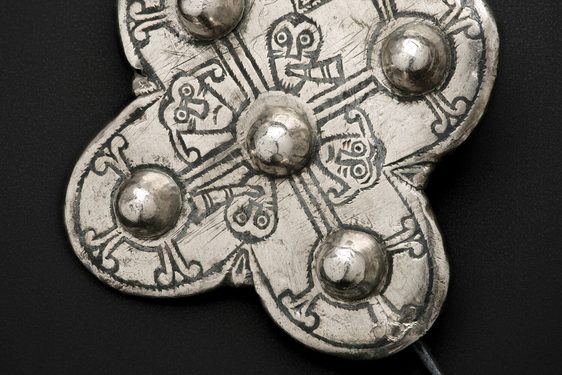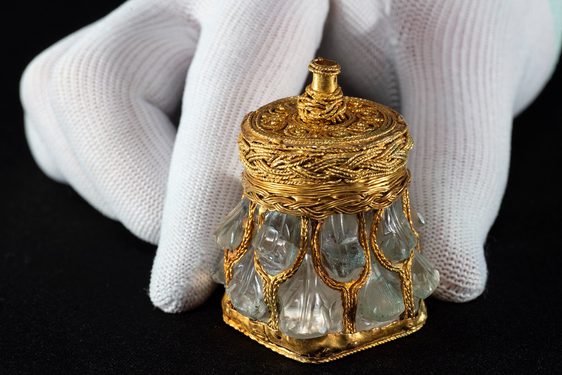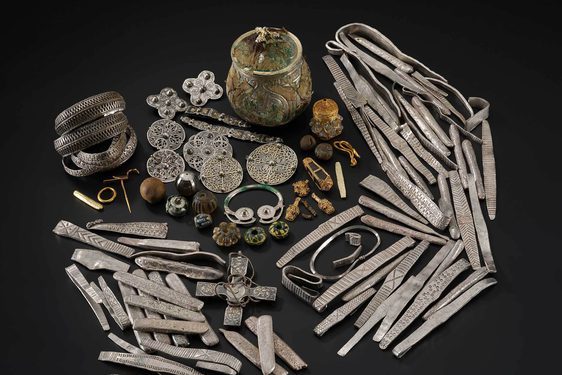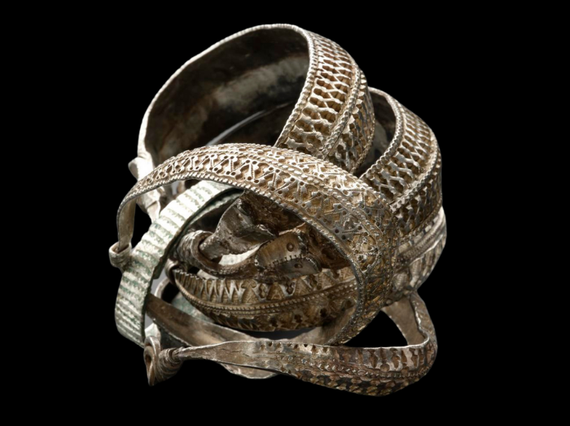
How ‘Viking’ is the Galloway Hoard?
News Story
When the Galloway Hoard was first unearthed in 2014, its piles of silver arm-rings and ingots made it seem like a classic Viking hoard. The more that we learn about it, the less ‘Viking’ it looks, even as it continues to give us incredible insights into the Viking Age.
Can we even call it a ‘Viking hoard’ anymore? We explore these terms using the Galloway Hoard as an example.
A Viking Hoard?
The Viking Age is usually used to refer to the period 800-1100 in Scotland. A ‘golden age’ of art and learning at Christian monasteries was disrupted by the sack of Iona in the Hebrides off the west coast of Scotland, in AD 795. It was the first of many such raids carried out by ‘heathens’, as the Irish annals often referred to Scandinavian warbands. By the middle of the ninth century, these ‘heathens’ had established permanent settlements in Ireland, and perhaps in the Hebrides. We now call these raiders and settlers ‘Vikings’.
It is only in modern times that the term Viking was used this way. The Old Norse word víking referred to journeys and activities far from home. A víkingr was a person who undertook such activities. But in British and Irish sources, these raiders were not called Vikings, and were only sometimes given an ethnic label like Norse or Dane. That is why some now suggest changing the spelling of Vikings to vikings. It is similar to the way we talk about ‘pirates’ not ‘Pirates’; more a job description than a people.
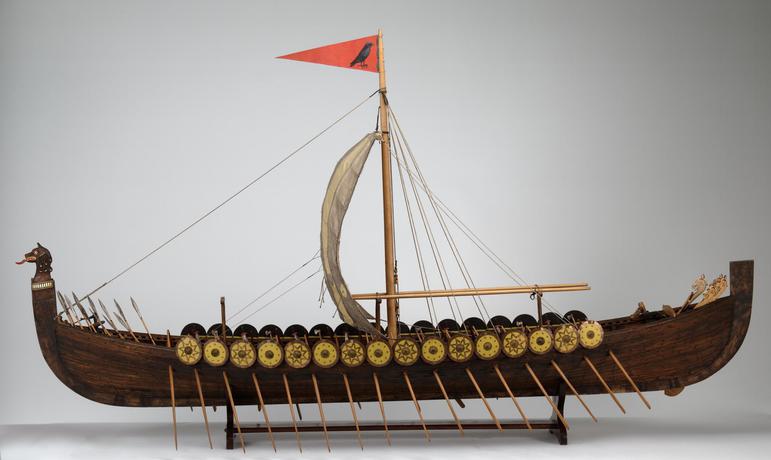
But while seaborne raiders grab all the headlines, the markets, camps, and settlements established through the ninth century were populated by men, women, and children, from various homelands. Most scholars still use ‘Vikings’ as an open and accessible term for all Norse-speaking peoples. Others have suggested it has too much baggage and should be abandoned altogether.
The Galloway Hoard gives us a good reason to revisit this debate. It is a hoard of two halves: one that looks very ‘Viking’, and another which has not much ‘Viking’ about it. Very little, if any, of these objects came directly from Scandinavia, and even the silver ornaments were produced in the Irish Sea area. So what is Viking about the Galloway Hoard?
New money: the arm-rings

The bulk of the Galloway Hoard consists of silver objects made to be hacked up as bullion, which could be weighed and used as an early form of currency. The ‘broad-band’ arm-rings and ingots were made from recycled good-quality silver, mainly coins. They were shaped into a distinctive new form of stamped arm-ring. From hoards that can be dated, they appear to have been used c. AD 880 to 930, so we can date the Galloway Hoard to c. 900. But it is still unclear where the silver came from, and where the arm-rings were made. The Pictish and Irish realms were not coin-using at this time, and did not exploit their natural silver ores, so the silver likely came from the Anglo-Saxon kingdoms or even further abroad.
These distinctive arm-rings were most likely being produced in Ireland. However, the largest hoards of them are from across the water, from Galloway and Cuerdale, Lancashire.
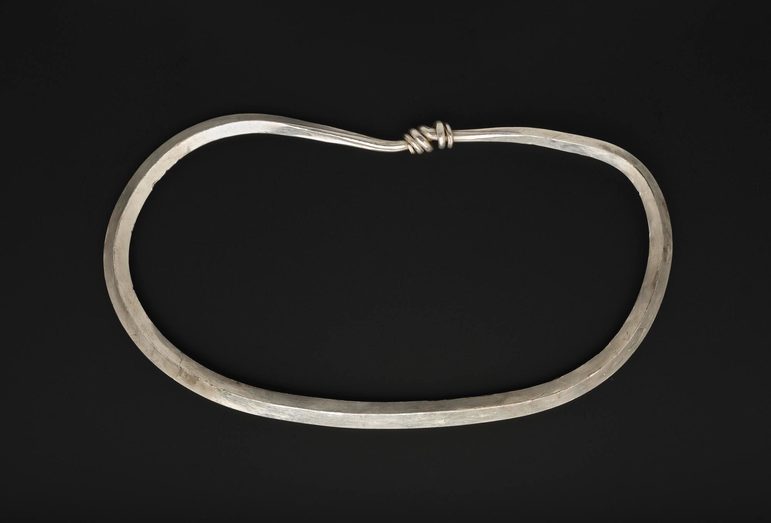
There is only one object in the Hoard which likely came from Scandinavia: a slender arm-ring fashioned from a single rod of silver. This is an early type of silver arm-ring common in Scandinavia, perhaps made in Norway. These arm-rings may have ultimately inspired the ribbon and broad-band arm-ring types seen in the Galloway Hoard.
The idea of using stamped silver arm-rings rather than coins as means of payment likely came via Scandinavia. But they were re-cast into a form specific to the Irish Sea zone and its markets. And as the Anglo-Saxon runes on the Galloway Hoard show, they could be adopted and hoarded by anyone with access to the hacksilver economy.
Old money? The Anglo-Saxon material
After the hacksilver objects, the next largest category of material in the Hoard is of ornaments made in Anglo-Saxon styles. These are doubly valuable because they represent classes of material never before found in Scotland, and some are still unique to the Galloway Hoard.
The most spectacular of these unique objects is the gold-mounted rock crystal jar. Its gold filigree ornament can be paralleled among Anglo-Saxon metalwork. However, it stands somewhat apart from the rest by its quality and technical achievement. It is the name of a Bishop Hyguald which tells us this must have come from a Northumbrian cathedral treasury.

Other objects, including many discovered inside a gilt-silver lidded vessel found within the hoard, are characterised by their ‘Trewhiddle-style’ artwork. This distinctive style is named after a hoard of similar material found in Cornwall. Despite the name, objects in this style were not just made in the kingdom of Wessex. Several Trewhiddle Style objects have been found in southwest Scotland, including objects from the Talnotrie Hoard deposited around the time of the Galloway Hoard.
We don’t often associate the Anglo-Saxons with Scotland, but for several hundred years the modern-day region of Dumfries and Galloway was part of the powerful kingdom of Northumbria. Old English was one of several languages spoken here, as evidenced by numerous place-names and objects inscribed with Anglo-Saxon runes. It just means that the Anglo-Saxon objects from the Hoard, rare as they are in a Scottish context, may have been the trappings of local Northumbrians.
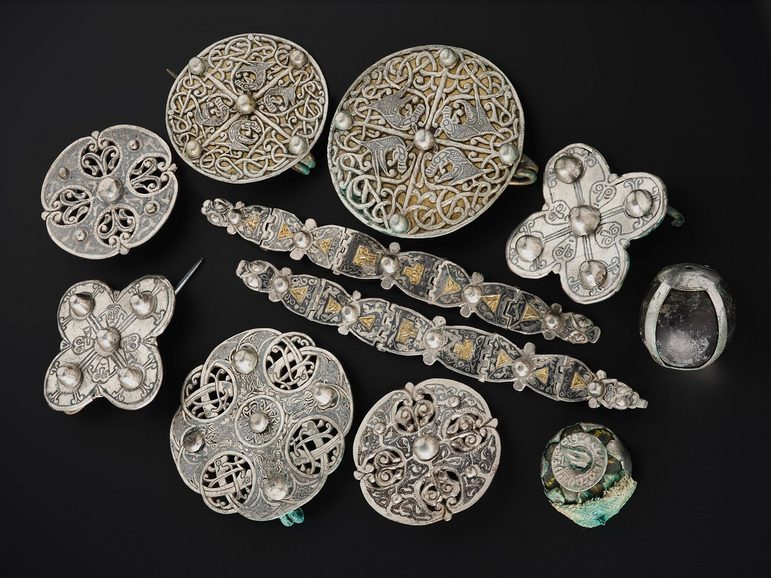
Other material
Given that many of the objects from inside the lidded vessel were already old when buried, is it possible the vessel was buried at a different time from the silver bullion? It is unlikely because there are objects in the vessel which seem to date from the same period as the hacksilver. A bossed penannular brooch and a reticella glass bead are both probably from Ireland. The brooch is another development of the late ninth century in Ireland. It indicates a new way of using up the new sources of silver that had begun to flow there in the age of raids.
Finally, the Hoard contains much more exotic materials. From fine silks to the silver lidded vessel itself, some materials seem to have come from Central Asia or further. It is likely, but not certain, that these came through the continent-spanning trade routes linking Britain and Ireland to the Byzantine and Islamic world which characterise the Viking Age.
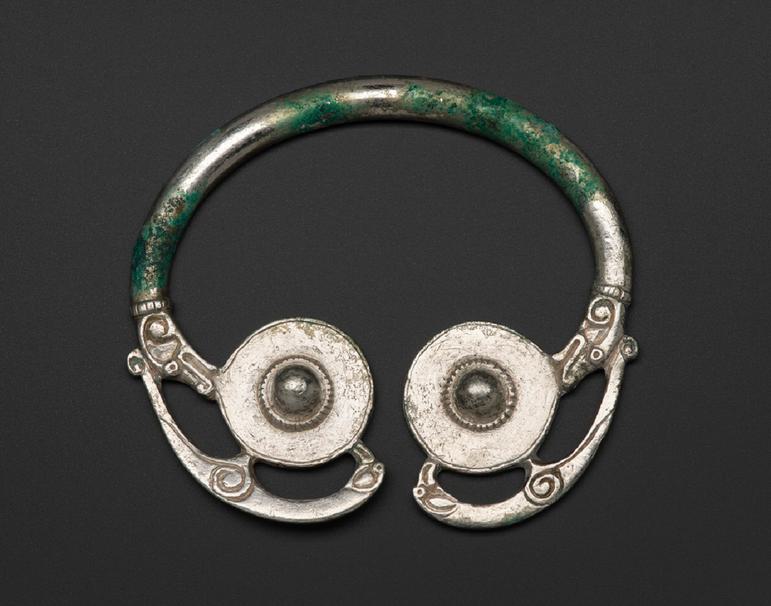
A Viking hoard?
Even pinning down the source of the objects in the Galloway Hoard cannot answer the question of who buried them. The Hoard contains Irish, Hiberno-Norse, Anglo-Saxon, Scandinavian and even more exotic objects. The bulk of the Hoard by weight is ‘Hiberno-Norse’ silver. But the most striking objects are the Anglo-Saxon ornaments. Some of these, like the pectoral cross and the gold bird-pin, were found amongst the parcels of hacksilver. And if the ‘Hiberno-Norse’ arm-rings were signed with Anglo-Saxon runes, then there really is very little ‘Viking’ about it at all.
But the trade routes which brought the far-flung objects to Galloway were certainly opened up and supplied by Scandinavian merchants and warlords. The huge wave of silver which reached the Irish Sea zone in the ninth and tenth centuries was the proceeds of an age of ‘Viking’ raids. Whoever last owned these objects, the new silver economy was indisputably an innovation of the Viking Age.
This is why rather than assigning any ‘ethnic’ value to the Hoard, we have chosen to refer to the Galloway Hoard as a Viking-age hoard, not a Viking hoard. The Viking Age was more than just about Vikings, and the Vikings were more than just Scandinavians. The Galloway Hoard is giving us a new way of looking at the Viking Age, as a global phenomenon, experienced locally.
